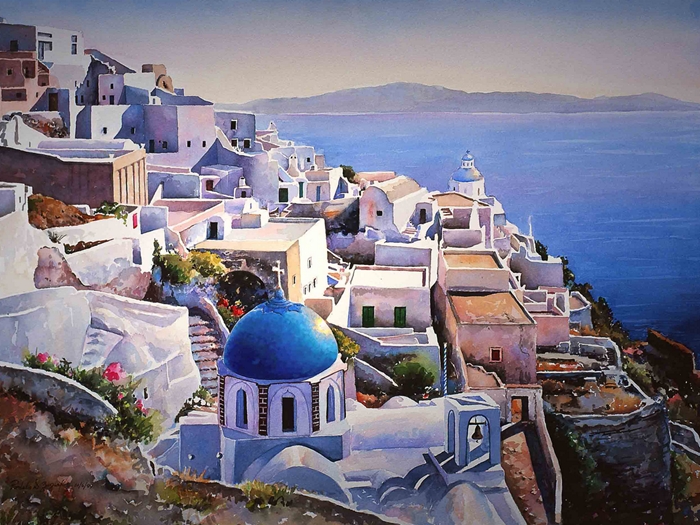Il pittore Italiano Ottorino De Lucchi è nato a Ferrara. Si è laureato in Chimica 1975 e Farmacia 1977 presso l’Università di Padova. E’ membro della Società Chimica Italiana dal 1977, dove ha ricoperto la carica di Presidente della Divisione di Chimica Organica e dal 1979 è membro dell’American Chemical Society. Nel 1984 ha ricevuto la medaglia Ciamician dalla Società Chimica Italiana, nel 1993 il premio Federchimica e nel 1997 il prestigioso Zeneca lecture prize, presso Wilmington, USA.
Home » Tutti i post

Ottorino De Lucchi, 1951

Jeff Legg, 1959 | Still Life painter
Jeff C. Legg’s artistic interests developed in childhood and by age 13, he was apprentice to a well known regional artist and college art professor Darrel Dishman. This nearly four years of mentoring under Mr. Dishman laid the foundation for his drawing and painting skills which led him to study at the Atelier Lack in Minneapolis and the Minneapolis College of Art and Design.

Scultura vegetale ~ L'arte Topiaria

Marcos Damascena, 1981 | Realist painter
Marcos Damascena was born in Poções Bahia and rooted in São Paulo, where he began his artistic career studying with what was considered the biggest names in art education in his country.
He studied drawing technique and live figure drawing with professor Luis Alberto, in the Association Paulista of Fine Arts. Afterwards, he studied the theory of color and anatomy of animals, with emphasis on the study of horses with the master, Jorge Abraham Esteves.
His talent developed with surprising speed.

Inmaculada Juárez, 1975 | Portrait painter
Inmaculada Juárez is a Spanish multidisciplinary artist, known for working in the Figurative style.
Juarez was born in Mota del Marqués (Valladolid) Spain and presently residing in Madrid.
Juarez works are so realist with a sense of warmth and are full of emotions.

Gilles Charest, 1947 | Still Life painter

Yasmina Alaoui, 1977 | Body Painter
Artist Yasmina Alaoui and photographer Marco Guerra love to tantalize their audience.
In their life-sized photographic series "one thousand and one dreams", statuesque bodies apear frozen in time, covered from head to toe in meticulously detailed, contemporary Arabic Henna patters.
Captivated by the realism and sculptural quality of each human form, the viewer becomes lost in an illusion.

Duma Arantes 1973 ~ Fashion painter

Edward Hopper (1882-1967)
Metropolitan Museum of Art | Edward Hopper was born in Nyack, New York, a town located on the west side of the Hudson River, to a middle-class family that encouraged his artistic abilities.
After graduating from high school, he studied briefly at the Correspondence School of Illustrating in New York City (1899-1900), and then he enrolled in classes at the New York School of Art (1900-1906).
In his shift from illustration to the fine arts, he studied with William Merritt Chase, a leading American Impressionist painter, and with Robert Henri, who exhorted his students to paint the everyday conditions of their own world in a realistic manner.

Bruno Torfs | Sculpture Garden
Bruno Torfs is an artist, born in South America and moved to Australia after traveling Europe up and down, wanting to bring his dream to life.
The Victorian village of Marysville, 95 km from Melbourne, was the perfect place to develop Bruno’s wish to create a sculpture garden.
He bought a property, including a generous piece of sub-alpine forest, and after five months of hard work, he opened to the public Bruno’s Art Sculpture Garden.

Klein Yves | Abstract / Nouveau réalisme painter
Yves Klein (28 April 1928 - 6 June 1962) was a French artist** considered an important figure in post-war European art.
He was a leading member of the French artistic movement of Nouveau réalisme founded in 1960 by art critic Pierre Restany.
Klein was a pioneer in the development of performance art, and is seen as an inspiration to and as a forerunner of minimal art, as well as pop art.

Fractalius | Il plugin artistico del digitale

Pantelis Zografos, 1949 | Watercolors of Greek Islands

Raffaello Sanzio | Drawings
Over forty sketches survive for the Disputa in the Stanze, and there may well have been many more originally; over four hundred sheets survive altogether.
He used different drawings to refine his poses and compositions, apparently to a greater extent than most other painters, to judge by the number of variants that survive: "...This is how Raphael himself, who was so rich in inventiveness, used to work, always coming up with four or six ways to show a narrative, each one different from the rest, and all of them full of grace and well done" wrote another writer after his death.

Olivia Beaumont | The Baroque Beasts paintings
I am a full-time artist and reside in a very small town near Savannah, Georgia, though I call California home. Painted portraiture is a long-time study and passion of mine. The Baroque Beast series serves my desire to make portraits using beastly attributes that the viewer can sympathize with on a level of human emotion. I believe society already identifies certain animals as noble, others as witty, still others as fierce. Because portraiture is semi-permanent, I believe this dignifies those characteristics, be they noble or barbaric.
Iscriviti a:
Post (Atom)
